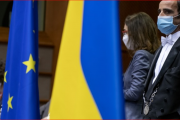Introduction:
The European continent, like all parts of the world, suffers from the cancer of terrorism. Even its democracy, secularism and economic and scientific progress didnt keep it away from terrorist attacks which targeted most of its capitals and major cities.
The European system carried, through its political, economic, social and cultural arrangements, its failure as the extremist ideology and groups were able to penetrate, exploit and hit this system at its core. It violated its privacy, threatened its security, restricted its freedom, exposed its democratic claims. Europe fell between m “the hammer of terrorism” and “its democracy and human rights approach”.
This challenge forces Europe to face terrorism strictly, not only through the security and military sides, but also through the intelligence cooperation between the European countries and the countries that export terrorism to it, and to work seriously to end conflicts in the “exporting terrorism” zones in the Middle East to provide solutions for those who return from conflict zones to Europe, which pose a grave threat to these societies.
Reasons for the spread of terrorism in Europe:
The terrorist operations in Europe have been linked to the so called of “lone wolves”. Most of the operations that occur in the European countries are carried out by individual elements where elements do not necessarily belong to a particular organizational faction, although they belong to it intellectually.
Among the most important reasons for the spread of terrorism in Europe are:
First: The participation of European countries in the war on terrorist organizations:
The participation of European countries in the war on Iraq and Afghanistan under the name of the “war on terror” at the beginning of the new millennium led to discontent and anger among the terrorist groups. This made the groups feel the need to revenge.
In 2014, 2015, after the emergence of the terrorist organization and the launching of the international coalition and the participation of a large number of European countries in the military operations against it, the elements of the organization – or those who follow them – vowed to “retaliate” from the countries which participating in killing them in Syria, Iraq, Libya and Yemen. She was clear during the Manchester attack, which killed 22 people in May 2017 as the attacked was a Libyan Daesh member. This was also appeared in the perpetrators of the attack on the French newspaper Charlie Hebdo, which killed 12 people, they belong to al-Qaeda.
Second: Factors of poor integration within European societies:
Most of the European societies suffer from the lack of integration. This is because there are many immigrants, as well as those of foreign origin, especially from the Middle East and the African continent. Some of them are integrated into the social environment while some others have been subjected to religious, economic and social discrimination. This made them hate the countries in which they live, making them “passive elements” that can be recruited by terrorist organizations and used in one form or another to carry out attacks against their countries.
Third: the colonial past of the European countries:
The spread of terrorism in Europe is partly due to the colonialist background of the European countries. Large part of terrorist attackers in Europe belong to North African Arab countries (Morocco, Algeria, Tunisia, Libya). After the independence of the North African countries, the economic situation in these countries deteriorated. This led some citizens in these countries to migrate to the West in search for work, decent and stable life. Some of them actually fused in these societies, but some of them became dangerous elements that threaten the security of these countries especially in the second and third generations of immigrant children, and the outbreak of unemployment and bad living conditions, which led to their transformation into dangerous elements that threaten the security and safety of their communities.
Fourth: The escape of extremist clergymen to Europe to escape security pursuits in their countries:
The evidence of this is when the Spanish police tracked the imam of the Catalan city of Ribol, Abdul Baki al-Saadi, who lived for two years there and is believed to be responsible for washing the brains of young Arab expatriates and pushing them to form a Jihadi cell responsible for the attacks in Barcelona. He was killed in an explosion before the Barcelona attack.
Fifth: The rise of the far right in Europe:
There is a general European drift to the far right, this is clearly shown in the rise of far right currents in Sweden, the United Kingdom, France, Austria, the Netherlands, Switzerland, Denmark, Germany and Italy.
The far Right beliefs are based on the hatred of immigrants, the rejection of their values and culture, and the seeing them as the cause of economic problems and unemployment. This has helped to create a “psychological barrier” between immigrants and foreigners and indigenous people. This made terrorist organizations fight them as they seek to conquer and isolate them. The relationship between the rise of the far right and terrorism is reciprocal. The spread of terrorism has led to the rise of the far right, and the rise of the right has fueled “terrorism”.
“There is a clear relationship between illegal immigrants coming to Europe and the spread of terrorism,” said Hungarian Prime Minister Viktor Urban, a right-wing politician. An important US security official in Hungary said the relationship between the two matters is clear.
Sources of Terrorism in Europe:
- Returnees from areas of terrorist conflict:
A number of Europeans joined the ranks of terrorist groups in Syria and Iraq. They gained combat experience and further extremism. After the terrorist groups in Syria and Iraq suffered heavy losses, these elements began to return to their original places in Europe which impose a real threat to the security and stability of these areas.
The total number of foreigners who fought with extremist Islamic organizations in Syria and Iraq is estimated at 27,000, with a large number of European nationals.
There are currently about 280 returnees (out of 820 left) in Germany, 450 in the United Kingdom, in France (about 210,000), in Holland (45 out of 280) ), In Belgium (about 120), in Belgium (about 120), in Norway (40 out of 100), in Sweden (150 out of 300), in Finland (20 out of 80).
Whatever the accuracy of these figures, there are extremists that have returned to their countries and are hostile to those countries as a result of their participation in the war against them in the Middle East.
The situation and movement of European security and intelligence surveillance of returnees from combat zones in the Middle East is extremely difficult to monitor. Recent terrorist incidents in Europe may prove to be a failure of the security services to anticipate terrorist attacks.
Second: Arrivals to Europe:
They are meant to come to Europe and do not possess the nationality of their own countries. They can be divided into two main branches: illegal immigrants and people who are paid to carrying out terrorist operations.
Illegal immigrants are fleeing from their countries of origin, and often North Africa, Arab countries and sub-Saharan Africa are smuggled into Europe through illegal routes. These pose a threat to the safety of European communities. There are 618780 illegal migrants in the EU in 2017. Statistics indicate that approximately 37% of non-Europeans are living illegally in EU countries in 2017, compared to 2016.
Sources of Terrorism in Europe:
I. Returnees from areas of terrorist conflict:
A number of Europeans joined the ranks of terrorist groups in Syria and Iraq, especially a sympathetic organization. These terrorists gained combat experience and further extremism. After the terrorist groups in Syria and Iraq suffered heavy losses, these elements began to return to their original places in Europe Which constitutes a real threat to the security and stability of these areas.
The total number of foreigners who fought with extremist Islamic organizations in Syria and Iraq is estimated at 27,000, with a large number of European nationals.
There are currently about 280 returnees (out of 820 left) in Germany, 450 in the United Kingdom, in France (about 210,000), in Holland (45 out of 280) ), In Belgium (about 120), in Belgium (about 120), in Norway (40 out of 100), in Sweden (150 out of 300), in Finland (20 out of 80).
Whatever the accuracy of these figures, there are extreme elements that have returned to their countries and are hostile to those countries as a result of their participation in the war against them in the Middle East, which represents a threat to its security and the security of its people.
The situation and movement of European security and intelligence surveillance of returnees from combat zones in the Middle East is extremely difficult to monitor and monitor terrorist elements. Recent terrorist incidents in Europe may prove to be a failure of the security services to anticipate terrorist attacks.
Second: Arrivals to Europe:
They are people who come to Europe but with no nationality of their own countries. They become between two main: illegal immigrants and people who are paid to carrying out terrorist operations.
Third: converting to Islam:
They are new to the Islamic religion from the European Union because of the spread of Islam in Europe for many reasons. The Takfiri groups reach them online and encourage them to believe in Jihadi idea and that they want to establish “the law of God”.
Fourth: The descendants of Arab and Islamic origins:
This is one of the tributaries of terrorism in the European continent. The European countries failed to contain young people of Arab and Islamic origin for reasons of economic injustice and social oppression. This led to the emergence of ethnic, cultural and racial ideas as well as injustice and marginalization, which led these young people to terrorist groups.
Muslims generally feel marginalized in European societies. For example, in the case of employment,
in Britain, an academic study (conducted by Bristol University academics in 2014 based on figures from the National Bureau of Labor Statistics) indicates that Muslims are the most discriminating group compared to the rest of minorities in England, where 76% of Muslim men have fewer opportunities to find a job after they are compared with White Britons, while 65% of Muslim women face counter-recognition in their careers.
The most famous terrorist cells in Europe:
– Ansar al-Islam: A terrorist organization with several activities in Britain, France and Italy. It was founded in Norway. One of its most important operations was “Charlie Hebdo.”
– Forsan al-Eza, which was founded in August 2010 by a Frenchman of Moroccan origin, Mohammed Al-Shamlan, and a number of young Islamists.
– “Sharia for Belgium”: founded by Muslim militants of Belgium in 2010, and is one of the most active cells in Belgium, which recruit jihadists to join Daesh.
– Migrant group: founded by Omar Bakri in Britain, and was banned in 2010.
– The Three Knights Cell: A group of extremists, who have called themselves Knights, and are targeting Britain.
– Libyan Islamic Fighting Group (LIFG), based in Manastar, is an intellectual group of al-Qaeda, and includes terrorists Abdul Hakim Belhadj and Khalid al-Sharif.
– Sharia for Britain: it has about 3 thousand members, most of them joined the group recently.
– The Sharia for Sweden: includes about 100 fighters claim to belong to Daesh.
The most highlighted terrorist operations in Europe:
There have been many terrorist attacks in Europe, caused by terrorist groups that falsely claim to belong to the Islamic religion. The most prominent of these operations can be observed since the beginning of the new millennium:
2004: In 11 March, over 190 people were killed in Madrid train bombings, which also injured over 2,000. Attacks also proliferated in Iraq and Pakistan.
2005: On July 7, 2005, the London bombings took place. Four militants carried out the attacks, which killed 50 people and wounded 700 others.
2010: On December 11, 2010, the Stockholm bombings occurred, with two bombs exploded in the center of the Swedish capital, killing the suicide bomber and wounding two people.
2011: On March 2, 2011, the Frankfurt incident occurred. An ethnic Albanian militant opened fire at the Frankfurt airport in Germany, killing two people and injuring two others.
2012: Between 11 and 19 March 2012, three operations took place in Toulouse and Montparne in France, killing seven people and injuring five others. The perpetrator of the incidents was identified as a single militant, Mohammed Marah, who was shot dead by the police.
On July 18, 2012, a suicide bomber blew himself up in Bulgaria. A suicide bomber targeted a bus carrying Israeli tourists at Burgas Airport, killing five Israelis and the bus driver and injuring 32 others. The Lebanese Hezbollah, which denied involvement in the attack, was charged.
2014: On May 24, 2014, a gunman opened fire on the Jewish Museum in the Belgian capital Brussels, killing four people. The accused, a Frenchman of Algerian origin, was arrested and linked to IS.
2015: On January 7, 2015, 12 people were killed in an attack on the Paris-based Paris-based magazine Charlie Hebdo, including journalists, painters and policemen. Two days later, the militants who carried out the operation were killed while trying to arrest them.
On 14 and 15 February 2015, attacks took place in the Danish capital of Copenhagen as a militant attached a seminar on the attack of Charlie Hebdo in France, killing one person and wounding three policemen. The next day, the same person attacked the Great Synagogue of Copenhagen, killing one person and wounding two. The police killed the attacker.
On 13 November 2015 there were attacks in the French capital Paris, which was the series of simultaneous attacks that resulted in the deaths of 130 people, mostly young people, in addition to 350 injured.
2016: On 10 February 2016, an explosive device detonated under a truck in Donetsk, the rebel stronghold of Ukraine, killing four people and injuring 11 others.
On March 22, 2016, more than 30 people were killed in a series of bomb blasts that included the Belgian capital Brussels and the Malbec metro station in the city and occurred a day after the arrest of Salah Abdel Salam, the prime suspect in the Paris attacks of November 2015.
On July 14, 2016, a Tunisian-born hardliner who was riding in a truck for a national celebration in the French city of Nice was run over, killing 84 people. The IS has claimed responsibility for the incident.
On July 19, 2016, an Afghan asylum-seeker attacked passengers on a train near the German city of Wurzburg, injuring at least five people. The 17-year-old was killed by police while trying to escape. The Islamic State Organization claimed responsibility for the incident.
On December 19, 2016, a truck driven by a militant ran over a crowd of people in a market in the German capital of Berlin, killing 12 people and injuring 50 others. The attacker, Anis Ameri, was later shot dead by Italian police in Milan on December 23, 2016.
2017:
On March 22, 2017, a bomber attacked a group of passersby on the Westminster Bridge and then stabbed a police officer, killing three people. The bomber, Khalid Massoud, 52, was a British national.
On October 2, 2017, a man attacked a number of passers-by at the Saint Charles train station, in the French city of Marseille, using a knife, killing two people. The attacker was killed after the military intervened. IS claimed responsibility for the operation later.
2018: On June 11, 2018, the Jane Center for Studies of Terrorism and Rebellion published a report that expected more terrorist attacks against European countries.
The Center’s report said that the collapse of the Daesh system in Syria and Iraq would prompt the organization to try to find a different ground for its terrorist operations to resurfaces after its sparks have subsided.
The report estimated that the number of terrorist attacks took place in Western Europe during this year was 44, leaving 334 dead and 2481 injured.
The phenomenon of Islamophobia in Europe:
Islamophobia as a term became known in English in 1997 when a left-wing British Takfiri cell used it to condemn feelings of hatred, fear and prejudice directed against Islam and Muslims. The term means hatred against Muslims.
The phenomenon of Islamophobia has grown with the growing member of migrants in Europe, whether legitimate or illegal, as well as the escalation of terrorist operations against European societies.
The negative image which was formed in the minds of Western citizens was due to the bloody events that occur in the name of Islam (such as the events of September 11, 2011 in the United States), the events of March 11, 2004 in Spain or the Paris attacks of 2015 and others). Also, the Western media played a central role in shaping these negative emotions by portraying Muslims in general as a group of terrorists who believe in violence.
In France, the National Front (extreme right) won 30% of the legislative elections in 2015, and then it’s head l Marine Le Pen was defeated in the 2017 presidential election. It was the anti-Islam front, which caused the rise of Islamophobia in France.
The growing phenomenon of fear and hatred of Islam and Muslims in Europe can be demonstrated through some statistics, including:
A poll conducted by the Chatham House Europe Program, showed the growing phenomenon of Islamophobia in Europe, confirming the Europeans’ rejection of Muslim immigrants from Muslim countries. The report presented an exploratory series entitled “All migration must stop from Muslim countries”. The majority agreed on the poll. 71% agreed in Poland, 61% agreed in France, 65% agreed in Austria, 63% agreed in Belgium and 65% in Hungary.
Ways that Europe used to confront terrorism
At the legislative level:
European countries have worked to counter the terrorism through legislation that criminalizes terrorist acts. It has been craving down in the perpetrators of the terrorist act. The most prominent example is the European Convention against Terrorism, in 2015, which aims to combat terrorism – whether committing crimes, recruiting or training for terrorist operations.
The provisions of the Convention confirmed that the parties concerned shall take the necessary measures to impose effective sanctions against terrorists.
As the terrorist attacks escalated further in 2015, the European Union approved the Additional Protocol to the Council of Europe Convention on Combating Terrorism in October 2015, which criminalizes membership of terrorist groups and organizations, traveling to fight, participating in training camps, recruiting and organizing travel and material support for fighters.
Under the Protocol, member States of the European Union should exchange intelligence and establish round-the-clock contact centers in order to achieve the desired cooperation.
The French Senate passed a new counterterrorism draft law, proposed by the French government as an alternative to the emergency law, to take effect from November 2018. In Britain, Britain’s new counterterrorism strategy, announced by British Home Secretary Sajid Javed on June 4, 2018, adopted counter-terrorism measures to counter what he described as ” Changing the nature of terrorists”.
In Germany, in 2016, a series of anti-terrorism laws were passed, allowing the security authorities to pre-empt strikes against terrorist networks.
At the level of security policies:
European countries have taken a number of security, intelligence and preventive policies to combat terrorism across the continent, including: the establishment of a database for air travelers to and from the European Union, after the approval of the Commission on Liberties and Basic Rights of the European Parliament in December 2016, (Europol), which began its mission in 1999 and works closely with EU and non-EU security agencies, including Australia, Canada, the United States of America and Norway.
In May 2016, the European Commission unveiled a security plan for the period 2015-2020 to support cooperation among the European bloc countries in combating terrorism, organized crime and cybercrime.
The plan identifies the tools and measures to be used in joint action to ensure security and to address those three most pressing threats effectively. The establishment of a center for gathering and disseminating expertise on countering extremism, providing a more coherent legal framework to deal with foreign fighters and intensifying cooperation with other countries on this issue.
In January 2015, the European Commission in Brussels adopted new measures relating to the handling of the Schengen Information System, which allows freedom of movement for European citizens. The new measures include allowing rapid exchange of information between law enforcement, State security authorities and border guards in the member states.
The four European Mediterranean countries: France, Italy, Portugal and Spain decided to form a special force in 1996 that can intervene by land and sea for security and humanitarian considerations determined by the general command of these forces.
The European Union also decided to establish the Frontex Agency in October 2004, which is an independent body charged with operational coordinating between Member States in border protection to strengthening the European border guard to curb illegal migration.
Its main functions are operational coordination and cooperation among Member States in the area of external border management, assisting Member States in training border guards, developing research related to the control of external borders and assisting Member States in circumstances requiring increased technical and operational support at the border.







































admin in: How the Muslim Brotherhood betrayed Saudi Arabia?
Great article with insight ...
https://www.viagrapascherfr.com/achat-sildenafil-pfizer-tarif/ in: Cross-region cooperation between anti-terrorism agencies needed
Hello there, just became aware of your blog through Google, and found ...